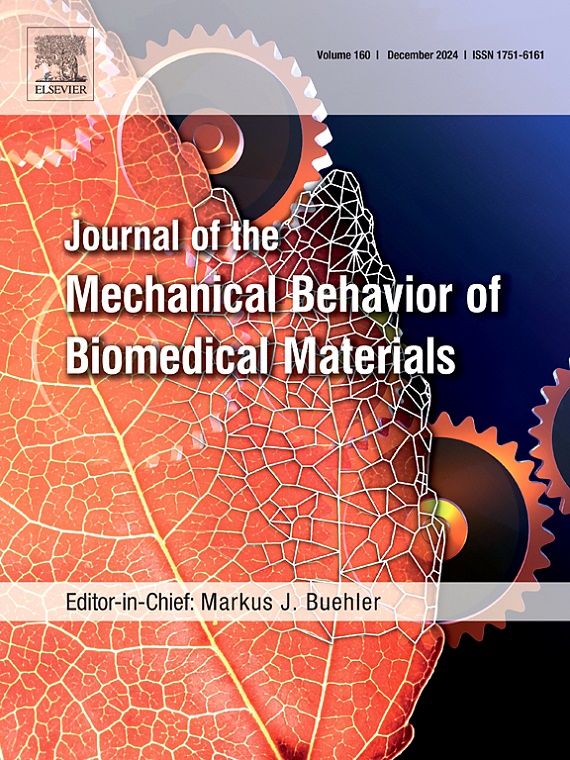乙烯基改性二氧化硅纳米颗粒用于mSLA:提高光固化PEGDA树脂性能和打印质量
IF 3.5
2区 医学
Q2 ENGINEERING, BIOMEDICAL
Journal of the Mechanical Behavior of Biomedical Materials
Pub Date : 2025-07-19
DOI:10.1016/j.jmbbm.2025.107142
引用次数: 0
摘要
通过用自合成的乙烯基功能化二氧化硅纳米颗粒(0.5、1、2、3和4 wt%)修饰聚乙二醇二丙烯酸酯(PEGDA)树脂,开发了用于家用3D打印机的新型生物相容性光固化树脂。乙烯基修饰的二氧化硅纳米颗粒(V-SNP)在405 nm光源激活时,在聚合物基体中充当密集交联扩链剂,同时保持疏水性。这种改性提高了光固化效率。树脂的力学性能得到明显改善(压应力由80 MPa提高到177 MPa)。V-SNP纳米颗粒的加入有效地散发了固化过程中产生的热量,最大限度地减少了气泡的夹带和空隙的形成,从而提高了打印质量。此外,细胞活力测定(CCK-8)显示出良好的生物相容性,V-SNP修饰树脂的细胞存活率为109%,而未修饰PEGDA树脂的细胞存活率为80%。使用微针模型的打印测试进一步证实了使用改性树脂制造详细、高质量微型结构的更高成功率。本文章由计算机程序翻译,如有差异,请以英文原文为准。

Vinyl-modified silica nanoparticles for mSLA: Promoting photocurable PEGDA resin performance and print quality
Novel biocompatible photocurable resins designed for home-own 3D printers were developed by modifying poly (ethylene glycol) diacrylate (PEGDA) resins with self-synthesized vinyl-functionalized silica nanoparticles (0.5, 1, 2, 3, and 4 wt%). The vinyl-modified silica nanoparticles (V-SNP) acted as dense crosslinking chain extenders within the polymer matrix when activated by a 405 nm light source, while maintaining hydrophobicity. This modification enhanced photocuring efficiency. The mechanical properties of the resin were substantially improved (compressive stress increased from 80 MPa to 177 MPa). The addition of V-SNP nanoparticles effectively dissipated heat generated during curing, minimizing air bubble entrapment and void formation, thereby improving print quality. Furthermore, cell viability assays (CCK-8) demonstrated excellent biocompatibility, with the V-SNP modified resin achieving a cell survival rate of 109 %, compared to 80 % for unmodified PEGDA resin. Printing tests using microneedle models further confirmed a higher success rate in fabricating detailed, high-quality miniature structures with the modified resin.
求助全文
通过发布文献求助,成功后即可免费获取论文全文。
去求助
来源期刊

Journal of the Mechanical Behavior of Biomedical Materials
工程技术-材料科学:生物材料
CiteScore
7.20
自引率
7.70%
发文量
505
审稿时长
46 days
期刊介绍:
The Journal of the Mechanical Behavior of Biomedical Materials is concerned with the mechanical deformation, damage and failure under applied forces, of biological material (at the tissue, cellular and molecular levels) and of biomaterials, i.e. those materials which are designed to mimic or replace biological materials.
The primary focus of the journal is the synthesis of materials science, biology, and medical and dental science. Reports of fundamental scientific investigations are welcome, as are articles concerned with the practical application of materials in medical devices. Both experimental and theoretical work is of interest; theoretical papers will normally include comparison of predictions with experimental data, though we recognize that this may not always be appropriate. The journal also publishes technical notes concerned with emerging experimental or theoretical techniques, letters to the editor and, by invitation, review articles and papers describing existing techniques for the benefit of an interdisciplinary readership.
 求助内容:
求助内容: 应助结果提醒方式:
应助结果提醒方式:


